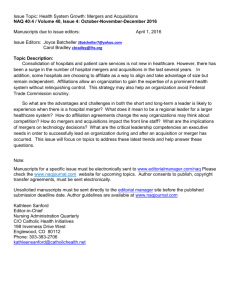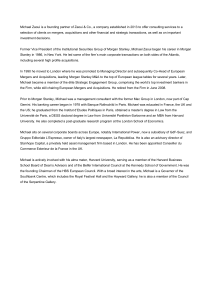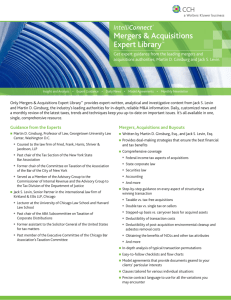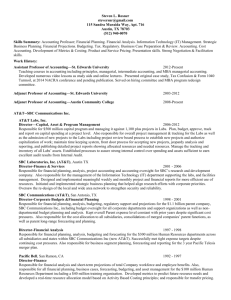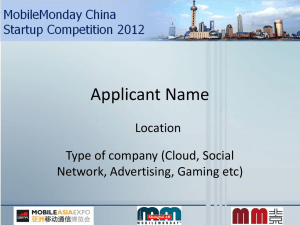Impact of Culture on Mergers and Acquisitions: A Theoretical
advertisement
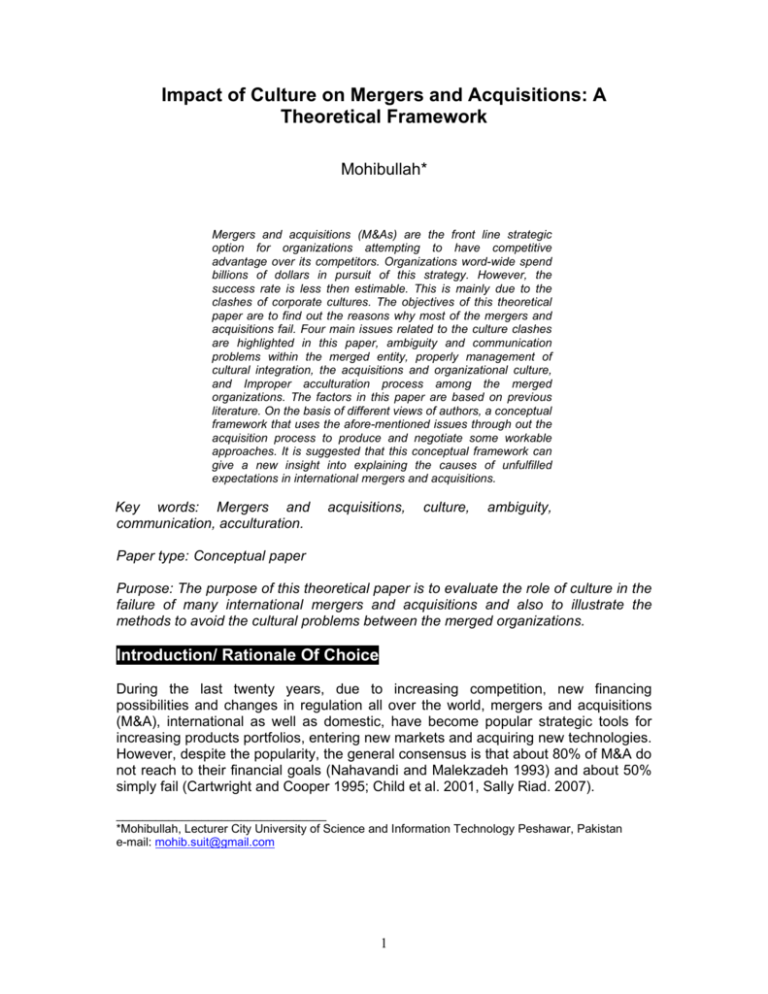
Impact of Culture on Mergers and Acquisitions: A Theoretical Framework Mohibullah* Mergers and acquisitions (M&As) are the front line strategic option for organizations attempting to have competitive advantage over its competitors. Organizations word-wide spend billions of dollars in pursuit of this strategy. However, the success rate is less then estimable. This is mainly due to the clashes of corporate cultures. The objectives of this theoretical paper are to find out the reasons why most of the mergers and acquisitions fail. Four main issues related to the culture clashes are highlighted in this paper, ambiguity and communication problems within the merged entity, properly management of cultural integration, the acquisitions and organizational culture, and Improper acculturation process among the merged organizations. The factors in this paper are based on previous literature. On the basis of different views of authors, a conceptual framework that uses the afore-mentioned issues through out the acquisition process to produce and negotiate some workable approaches. It is suggested that this conceptual framework can give a new insight into explaining the causes of unfulfilled expectations in international mergers and acquisitions. Key words: Mergers and communication, acculturation. acquisitions, culture, ambiguity, Paper type: Conceptual paper Purpose: The purpose of this theoretical paper is to evaluate the role of culture in the failure of many international mergers and acquisitions and also to illustrate the methods to avoid the cultural problems between the merged organizations. Introduction/ Rationale Of Choice During the last twenty years, due to increasing competition, new financing possibilities and changes in regulation all over the world, mergers and acquisitions (M&A), international as well as domestic, have become popular strategic tools for increasing products portfolios, entering new markets and acquiring new technologies. However, despite the popularity, the general consensus is that about 80% of M&A do not reach to their financial goals (Nahavandi and Malekzadeh 1993) and about 50% simply fail (Cartwright and Cooper 1995; Child et al. 2001, Sally Riad. 2007). ________________________________ *Mohibullah, Lecturer City University of Science and Information Technology Peshawar, Pakistan e-mail: mohib.suit@gmail.com 1 It is true that mergers and acquisitions do fail due to the reasons of financial and economic nature; but making a successful mergers or acquisitions, as most of the organizations have learnt to their cost, is more than ‘getting the sums right’. Many firms have also come to recognise that a compatible and successful organizational marriage depends upon the characteristics of the partner, which extent beyond the suitability of the strategic match. Financial advisors may guide merger managers in suggesting the broad areas in which economic of scale may be achieved, but they do not have to translate them into practice and physically implement such decisions (Cartwright and cooper, 1992. Lodorfor 2006). Cultural clashes between the two merging companies have been one of the most common explanations. Most of the researchers put this blame for the lack of success on cultural differences between the companies and the difficulties in these differences create in merger and acquisitions company integration (Buono et al. 1985; Datta and Puia 1995; Veiga et al. 2000). Difficulties encountered in M&A are augmented further in cross-cultural situations, when the companies involved are from two or more different countries. People working in different countries may react to the same circumstances or events in very different behaviours. So, it is important for an organization involved in an international merger or acquisition needs to consider these differences right from the design stage if it is to succeed. However, one should also not forget that combinations between organizations with well-matched and highly compatible cultures would face to met expectations if they are insensitively or poorly managed, conversely, in situations where the cultures of the combining organizations are highly dissimilar and potentially incompatible. Good management can still prove effective. Literature Review Explanations For The Failure Of Mergers and Acquisitions The success of mergers and acquisitions are directly proportional to the level and quality of planning involved. Organizations often spend insufficient time to analyse and anticipate current and future market trends as well as integration issues. Firms allocate insufficient resources to establish strategic objectives. Many transactions also fail or suffer significant setback as a result of insufficient due diligence performed on the target company (Oon, 1998). However, research shows that the opportunity for mergers fail is greatest during the integrated process (Simpson, 2000). Integration fails because of improper managing and strategy, culture differences, delays in communication and lack of clear vision. Mergers and acquisition has a very long history; it has been existed at least since the 1900s (Gaugan, 1999). However, the saliency of M&A has increased considerably during the past two decades as numerous US firms have adopted M&A as a common corporate strategy to expand their organizational capabilities and to take better competitive market positions (Buono and Bowditch, 1989, Sally Raid, 2007). This propagation continued during the 1990s, and beyond, including 7,809 M&A transactions with a total value of $1.19 trillion in the United States in 1998 alone (Guaghan, 1999). Now the question mostly asked about mergers and acquisitions is why such a high percentage of these transactions fail to meet expectations, estimates ranging from 60% to two-thirds (Gilkey, 1991). Most of the scientists and researchers who searches the literature for clear and systemic answers to question 2 did not found the right answer. However, some progress has been made to find out the suitable answer. Past research on M&A has focused on either the effect of various financial issues, such as the mode of transactions and the number of bidders, or the performance implications of various strategic issues, in particular, the level of relatedness. For example, a general but still inconclusive claim is that related M&A display superior performance as compared to unrelated M&A by providing better synergy due to economies of scale and scope (Datta, 1991). As neither financial nor strategic perspectives provide sufficient explanations of why nearly half of M&A fail to fulfil prior expectations, However, recent researchers attention has shifted to the human side of M&A, exploring the issues of organizational fit and/or the actual organizational integration processes (Hogan and Overmyer-Day, 1994). Gilkey (1991) also argues that: the high percentage of failure is mainly due to the fact that mergers and acquisitions are still designed with business and financial fit as primary conditions, leaving psychological and cultural issues as secondary concerns. A close examination of these issues could have brought about a learning process, directed at successfully managing such ventures (Gilkey, 1991, p.331). So, in this the author will argue that by studying the concept of acquisitions through a different perception, a cultural ambiguity structure, helps us to understand the complexity of these phenomena in a better way and perhaps it can prevent some unwanted results. Communication is particularly highlighted as a useful device to negotiate meaning out of the acquisition ambiguities. During the last twenty years, management of “the human factor” in mergers and acquisitions has been recognised as an important source of success by an increasing number of authors (Kimberly and Quinn, 1984; Bueno and Bowditch, 1989; Cartwright and Cooper, 1992; Gilkey, 1991; Lubaktin and Lane, 1996). These authors present precious insights in the part played by culture; however these insights look like to be spread around, waiting for integration in an agreed-upon body of knowledge. In working towards a higher level of integration, one of the first questions that must be answered is how the part that culture plays in success or failure of organizational melting processes can be envisaged, has been explained in this conceptual framework. Culture Differences The cultural incompatibility is the single largest cause of lack of projected performance, departure of key executives, and time consuming conflicts in the consolidation of business (Bijilsma-Frankema, 2001). Culture plays a vital role in the way how employees react to the new organization culture environment. BijilsmaFrankema, 2001 argue that the term ‘Culture clash’ has been coined to describe the conflict of two companies’ philosophies, styles, values, and missions. This may, in fact, be the most dangerous factors when two companies decide to combine. Even in the best circumstances, mergers can so change the nature, orientation and character of one or both of the merger partners; this means five to seven years are typically required for employees to feel truly incorporated into a merged entity (Covin et al, 1997). Due to the multitude of these changes, the post-merger period witnesses many problems adjustment (Mirvis and Marks, 1992). Most of these adjustments problems arise from employees’ fears regarding the loss of job, also financial debt regarding job loss. Moving into the realm of the unknown with a new manager and a 3 new team is also distressing and anxiety provoking (Mirvis and Marks, 1992). Other fears include the loss of effective and close team members, as well as the uncertainty about the new team members and supervisors to be inherited. When forced to deal with new team members and supervisors, employees may frequently develop fears of taking risks and raising sensitive subject. This may adopt ‘us verses them’ thinking, where trust for the new team members will be minimal (Mirvis and Marks, 1992). Corporations facing this kind of behaviour may have to pay the high price of loss of cooperation and initiative among the employees of the new business combination. The synergies that were initially sought may be harder to achieve, conflicts and disagreement will be more difficult to resolve, if at all, and this friction occur more frequently, post-merger will be the most difficult time for the new team to move forward as a whole (Appelbaum et al, 2000). Ambiguity and Communication Problems With The Merged Entity According to Feldman (1991:p. 146), ambiguity occurs in an organizations when there is “no clear interpretation of a phenomenon or set of events”. This is rather a general definition for various situations in the organization’s activity. Meyerson (1991) argue that individuals’ understanding of an event can very through out the organization. She further explains that ambiguity can exist within the organization as a whole as well as within individuals’ own cultural knowledge. So, ambiguity can exist in different set of event in an organization. So, different individuals in the organization can experience different kind of ambiguity at different intervals. Ambiguity in organizations has been identified and labelled many times (Cohen and March 1974; Khan et al., 1964; March and Olsen, 1976). In short the idea for all these types ambiguity is the lack of sufficient information and communication among the individuals. Khan et al. (1964) further argues that ambiguity as “the lack of clear, consistent information” (Khan et al 1964, p. 23) Frost et al. (1991) also tie ambiguity with communication, declaring that it is probably resolvable by the provision of more information. These definitions indicate the relationship between the organization ambiguity and the information communicated. So, it is obvious that communicated information could be a way to decrease ambiguity in certain situations, however wrong communication might increase ambiguity. When a new firm is established, out of two formerly independent ones, at least for a part of the employees there will be a change in structure and work processes that they have to adapt. These changes will occur, since two independent firms rarely show the exact similarity in a way they organize work processes and in what they expect from their employees. Hence, it is the fact that organizations becoming global or in Martin and Meyerson’s (1991) terms, ambiguous, must be recognised in the communication. Schein, (1993) argue that if you understand another culture, you will more easily acknowledge it. Thus, communication could be a help towards acknowledging multiple cultures within an organization and to facilitating the co-operation among the cultures. Davis and Jasinski (1993) further view importance of communication that it should be used to produce and negotiate meaning for the individuals involved. The proper management of change in an organization can be possible due to proper communication in the organization. Young and Post (1993, p.36) found in their study that communication was too important to make employees less resistant to change. 4 Furthermore, their results also indicate that the initiative for communication must come from top management and that it should be continuous throughout the change period. It is also vital that there is no discrepancy between action and words; too often ‘the implicit messages as conveyed in formal communications’. Thus, communication is an important tool to manage a change such as acquisition (e.g. Scweiger and DeNisi, 1991), however, it must be reliable to avoid confusion. Unreliable communication could be determined during the first phases of the acquisition process as many form their opinions about the acquiring company early in the process. Management Of Cultural Integration Not only is lack of communication a serious issue for merging organizations, the deliberate withholding of information from employees on the part of the senior executives who are dealing with the merger is also a major problem, and contributes to confusion, uncertainty and loss of trust and loyalty on the part of employees. Several authors argue that, as organizations move from functional forms to network forms, organizational performance becomes increasingly dependent on trustful relations between organizational members. A high level of trust with in a network form is seen as a functional equivalent of building and maintaining control in functional forms (Miles and Snow, 1994). A broadly acknowledged idea is that trust, partly brought about by managerial beliefs, philosophies and actions, reduces transaction costs. If relationships are of a trusting nature, expenditures on control, checks, monitoring and the like can be minimized (Cumming and Bromiley, 1996; Powel, 1990; Sheperad and Tuschinksky, 1996). In addition to this idea, some authors argue that if control is not minimized, trust will decline, because trust and control are central elements of two organizations. Handy (1993) even states that as a result, trust in subordinates and control over their work on the part of the manager is a constant sum, whereas an increase in the amount of control decrease the amount of trust by the same quantity solutions. The question of how these careful balanced solutions look like is still to be answered, partly because little is known about which managerial behaviours or actions make a difference in the eyes of subordinates as to whether a manager is trusted or distrusted. The balance between managerial behaviour and the trust among their subordinates can be minimised by shared norms, because they diminish the chance of people misinterpreting mutual expectations. For example a person who does not want to harm others might do so if he or she doesn’t understand their norms and expectations. An important means to proceed towards more sharing of norms is a regular dialogue between two parties, in which the ways of thinking and reasoning are exchanged and norms and expectation are explicitly communicated. (Garfinkel, 1967) Argyris (1983) argue that dialogue can involve exchanging ways of thinking and reasoning that have brought about conclusions people draw on each other’s behaviour. Merely exchanging conclusion does not bring about a common learning process. Learning about each other’s way of reasoning adds to mutual understanding, and assists comparison: is the other’s one’s reasoning really so different or just an alternative pathway taken from a common ground? Do the alternative paths reply to specific situations, each with its own success value? Can they be seen as supplementing each other? Can both ways of thinking be combined 5 in a new logic? These considerations, potentially furthering integration, may arise thanks to the quality of a dialogue over the simple exchange of conclusions. Acquisition And Organizational Culture Most of the acquisitions suffer due the culture clashes. To date, the literature has explained culture in terms of “value” similarities and differences. To make acquisitions work, most of the research has focused on finding fits between the combining companies (Jemison and Sitkin, 1986), for example, similarities in management styles and corporate culture (Nahavandi and Malekzadeh, 1988). There is underlying assumption that to reach the best outcomes of the acquisition, the two organizations should be integrated (Shrivastava, 1986) to make them as similar as possible by attaining a mutual corporate culture. Haspeslagh and Jemison (1991) do not fully prescribe integration in all acquisition. They mean that different degrees of integration should be used depending on the nature of the acquisitions. Unfortunately, the acquired company is often forced to adapt to the acquiring company’s culture and routines (Napier et al, 1989), which may lead to difficulties in their adaptation to the parent company. The other way round should also be implemented, it is just a question that which of the two organizations has a better organizational culture. A culture viewed from an ambiguity perspective cannot be characterized as being either in harmony or conflict. Instead, individuals share some viewpoints, disagree about some, and are ignorant of or indifferent to others (Martin and Meyerson, 1991). The other view as the acquired company should be assimilated into the acquiring company’s culture is probably grounded in today’s existing organizational theories which do not account for cultural differences within the organization (Fines, 1991). With in one organization there exist many different cultures derived from the people working in the organization, different cultures that can be due to differences in ethnicity, gender or nationality. In these organizational theories, organizational culture is viewed as something that homogenises the organization and its members (Martin and Meyerson, 1991). So, when two cultures are brought together, the existing theories often seem to assume that one of the two should assimilate into the other existing organizational culture to make the new organization work (Berry, 1980, Nahavandhi and Malekzadeh, 1988). However, an organizational culture rarely has values and assumptions that are shared by all organizational members. Instead it may consist of different subcultures that may have quite conflicting assumptions about reality (Schein, 1993). Martin and Meyerson (1991), further specifies three perspectives that can be used to study the corporate culture: the integration perspective, the differentiation perspective and the ambiguity perspective. The first perspective is called integration because it emphases consistency among cultural manifestations, for example events and artefacts, and organization-wide agreement among cultural members, as discussed above. Using this view in acquisitions would mean that the members of the combining companies deny the differences between them. However, it is more likely that it is the top management denying the differences, forcing the two companies to become one with a homogenous culture. The top management does not want to face the ambiguity that may occur because of culture differences and that’s why they deny them. Acquisition research about the differentiation perspective has also been used. 6 It stresses the inconsistency and lack of compromise in the corporate culture and views culture as either pleasant or conflicting. As discussed earlier most of the failure found in acquisition has been explained by culture clashes (e.g Buono and Bowditch, 1989). Cultural clashes can be explained as when the two merging companies find dissimilarities in their corporate cultures. The differentiation perspective like integration perspective does not deny ambiguity rather it emphasis on subcultures and the differences between them, for example the difference between marketing culture and engineering culture, and does not even acknowledge sources of organization wide agreement (Marting and Meyerson, 1991). “Subcultures differentiation ‘fences in’ these clear differences in perspective. Each subculture becomes an island of localised simplicity; ambiguity lies only in the interstices among the subcultures. The differentiation paradigm (perspective) channels ambiguity as swift cultures create channels around islands” (Martin and Meyerson, 1991, p.112) When it comes to acquisitions, the subcultures are represented by the two merging companies. Instead of denying that differences exist between their cultures, they focus on the differences. Within each company they emphasise agreement, while the differences will occur in the interaction between the two companies. The third perspective, ambiguity, considers that cultural manifestations are not clearly consistent or clearly inconsistent with each other .The corporate culture is, instead, viewed as fragmented, consisting of many subcultures with both different and shared values. When the two corporate cultures meet, the ambiguity is acknowledged and sometimes even made the focus of attention. A culture viewed from an ambiguity perspective cannot be characterized as being either in harmony or conflict. Instead, individuals share some viewpoints, disagree about some, and are ignorant of or indifferent to others (Martin and Meyerson, 1991). This can be a very fruitful view for understanding cultural encounters, particularly in cross-cultural acquisitions where ambiguity and uncertainty can easily occur because of difficulties in communication. People with different cultural backgrounds bring different meanings, values, and assumptions into workplace related conversations. These are differences that often lead to misunderstanding and breakdowns in communication and can threaten a common orientation to organizational goals (Fine, 1991; Limaye and Victor, 1991; Schein, 1993). Acculturation Process Nahavandhi and Malekzadeh (1988, p. 82) cited in Salama, (2003) adopt the anthropological term acculturation to illustrate the cultural changes resulting from the interaction of one organizational culture with another. Cultural differentiation; and organizational forces for integration are the basis of acculturative process. This has been observed by Buono and Bowdich (1989, p. 105) cited in Salama, (2003) that some individuals may refuse to give up particular culturally bound ideologies, traditions or behaviours, and therefore may purposely delay the acculturation process, or “lag” behind the rest of the organization in terms of accepting culture change (Vansina, 1991). Salama, (2003, p. 314) further elaborate that acquisitions selections decisions are generally driven by financial and strategic considerations, yet many organizational alliances fail to meet expectations because of difficulties in 7 the acculturation process which would compromise the knowledge transfer and learning to occur. These kinds of difficulties in the acculturation process could be a function of either or both of the integration strategies or the incompatibility of the partners’ cultures (Carwright and Cooper, 1992). Conclusion By analysing various authors’ views in the literature the mergers and acquisitions situation from an ambiguity perspective, communication seems as the most important perspective to be understood in the whole merging process. Inappropriate communication is the origin for many of the ambiguities seen in mergers and acquisitions. If proper communication among employees from top to down wards has been understood through out the entire mergers and acquisitions process, many of the ambiguities may have less severe or avoided entirely. Moreover, if different culture backgrounds have been acknowledged, some of the ambiguities may also have been avoided if they occurred owing to misunderstanding in the communication. The second most important factor is how to proper manage the cultural integration process? Thus, if employees do not feel secure, trust in the top management declines. As a result, they will be unaware about what is going on in their work in interactions with the manager. In this way, it is possible that managers can miss important information regarding the integration process. As to the process of cultural integrations, trust was also found to be a key factor in furthering co-operation between groups with different cultures. Trust in the newly merged organization can be enhanced by shared goals, regular dialogues, shared knowledge about similarities and differences in norms and expectations making agreements, monitoring compliance and agreements, active handling of non-compliance, and beforehand agreement on conflict resolution. Regular dialogues among the merged organization seem to be a key factor in trust building. The conceptual framework derived here reported preliminary results of an ongoing research work. Suggestions in this paper can be applicable on mergers and acquisitions in countries where cultural clashes are highly existed. The author does understand that this conceptual framework needs further improvement while applying on cases related to mergers and acquisitions. Acknowledgment I am very thankful to my fellow lecturer M/S Sumera Mustafa for her kind cooperation and help regarding completion of this paper. References Appalbaum, S.H., et al (2004), “Anatomy of a merger: behaviour of organizational factors and process throughout th pre-during-post-stages”, Management decision, Vol.38, No.2, pp.649-62 Berry, J.W. (1980). “Acculturation as variety of adaption,” Padilla, A.M., “Acculturation- Theory, Models and some New findings, westview Press, Boulder, CO. 8 Bijilsma-Frankema, K. (2002), “On managing cultural integration and cultural change processes in mergers and acquisitions,” Journal of European Industrial Training, Vol. 25, April, pp. 192-207 Buono, A.F., Bowditch,J.L.1989. “The Human side of Mergers and Acquisitions” San Francisco: Jossey-Bass. Cartwright, S. Cooper, C.L.(1992). “Mergers and Acquisitions The Human factors.” Oxford, Butterworth-Heineman Cartwright, S. Cooper, C. L. (1995). “Organizational marriage: “Hard” versus “Soft” issues?”. Personal Review, Vol. 24, n.3, pp. 33-42 Child, J., Faulkner, D. Pitkethly, R. (2001) acquisitions.” Oxford University Press “The management of international Cohen, M. March, J.G. (1974). “ Leadership and Ambiguity.” The American College President, 2 Covin, T.J., Kolendo, T.A., Sighter, J.W. and Tudor, R.K. (1997), “Leadership style and Post-merger satisfaction,” Journal of management development Creed, W.E.D., Miles, R.E. (1996). “Trust in organizations: a conceptual framework.” London, Sage. Cumming, L.L. Bromiley, P. (1996). “The organizational trust inventory.” London Sage Datta,D.K. (1991). “Organizational fit and acquisition performance: Effects of postacquisitions integration.” Strategic management journal, 12:281-297. Datta, D.K. Puia, G. (1995). “Cross-border acquisitions: An examination of the influence of relatedness and cultural fit on shareholder value creation in U.S. acquiring firms.” Management of International review, vol. 35, n.4, pp. 337-359 Davis, D.K. and Jansinki, J. (1993) “Beyond the culture wars: an agenda for research on communication and culture” Journal of communication, summer, pp 141-9 Feldman, M.S. (1991) “The meanings of ambiguity: learning from stories and metaphors”. Frost, P.J. Moore, L.F. Reis Louis, M.Lundberg, C.C. Martin, J. Reframing Organizational Culture, New Burry park, Sage. Fine, M. (1991). “New voices in the workplace: research directions in multicultural communications,” The Journal of business communication, 28,3 259-75. Frost, P.J. Moore, L.F. Reis Louis, M. Lundberg, C.C. Martin, J. (1991). “Reframing Organizational Culture.” Newburry Park, Sage, CA. Garfinkil, H. (1967). “Studies in Ethnemethodology.” Prentice Hall 9 Gilkey, R. (1991). “The psychodynamics of upheaval: intervening in merger and acquisitions transactions.” San Francisco: Jossey-Bass. Gaughan, P. A.(1999). “Mergers, Acquisitions, and Corporate Restructuring.” New York: John Wiley and Sons, Inc. Ghauri, P.N. Gronhaug, K. (2002). “Reasearch Methods in Business Studies: A Practical Guide,” 2nd Edition. Harlow. Financial Times and Prentice Hall Handy, C. (1993). “ Understanding organizations.” 4th Edition. London: Penguin. Haspeslagh, C. Jemison, B., (1987). “Acquisitions: myths and reality.” Sloan Management review, Winter. Haspeslagh, C. Jemison, B. (1991a) “Managing Acquisitions-Creating Value through Corporate Renewal,” New York, The free press. Hogan, E. Overmyer-Day, L. (1994). “The Psychology of mergers and acquisitions.” International review of industrial and organizational psychology, 9: 248-281. Jimson, D.B. Sitkin, S.B. (1986). “Acquisitions: the process can be a problem.” Havard business review, March-April, 107-16 Khan, R.L., et al.(1964). “Organizational Stress: Studies in Role Conflict and Ambiguity.” New York, John Wiley and Sons, NY Limaye, M.R, and Victor, D.A (1991) “Cross-cultural business communication research: State of the art and hypothesis for the 1990”, The Journal of Business Communication, vol. 28 No. 3. Summer, pp. 277-99 Lodorfor.G. A. Boateng (2006). “The role of culture in the merger and acquisition process. Evidence from the European Chemical Industry,” Management Decision, vol. 44 No.10. p.p 1405-1421. March, J. Olsen, J. (1975) “The Uncertainty of the past: organizational learning under ambiguity.” European Journal of Political Research, 3, 149-171. Martin. J. and Meryson.D. (1991) “Organizational cultures and the denial, channelling and acknowledgement of ambiguity”, in Ponday L.R.Boland, R.J. and Thomas. H. (EDS) “Managing ambiguity and change”, John Wilay and Sons, New York, NY Miles, R.E. D. (1994) “The human side of enterprise.” New York, Free press. Mirvis, P.H. and Marks, M.L. (1992), “Rebuilding after the merger: Dealing with survivor sickness,” Organizational Dynamics, Vol. 21. No.2, pp. 18-23 10 Nahavandi, A. Malekzadeh, A.R. (1988), “Acculturation in mergers and acquisitions”, Academy of Management Review, vol, 13, pp. 79-90 Nahavandi, A. Malekzadeh, A.R. (1993). “Organizational Culture in the Management of Mergers.”. Westport, CT: Quorum Books. Napier, N.K. Simmons, G. Stratton, K. (1989). “Communication during merger: the experience of two banks.” Human resources planning, 12, 2 Oon, C.T. (1998), “Due diligence vital for successful mergers”, The New Straits Times, 3 February, Vol.15 Powel, W.W. (1990). “Neither market nor hierarchy : network forms of organization.” Greenwich: JAI press. Salama. A (2003) “Challenges and opportunities in mergers and acquisitions: three international case studies-Deutsche Bank-Bankers Trust; British Petroleum-Amoco; Ford-Volvo.” Journal of European Industrial Training. 313-321 Sally. R (2007) “Of mergers and cultures: “What happened to shared values and joint assumptions?” Journal of organizational change management vol. 20. No. 1 pp. 2643. Schein. E (1993) “On dialogue, culture, and organizational learning”, Organizational Dynamics, Vol. 22. No.2, Fall, pp. 40-51 Schein, L. (2001). “Managing culture in mergers and acquisitions.” New York: The conference Board (Research Report R-1302-01-RR). Scweiger, D.M, and DeNisi, A.S (1991) “Communication with employees following a merger: a longitudinal field experiment”, Academy of Management Journal, Vol.34 No. 1, pp, 110-35 Simpson, C. (2000), “Integration framework: Supporting successful mergers,” Mergers and Acquisitions in Canada, Vol. 12 No. 10, 1 October, P.3 Sheppard, B. Tuchinsky, M. (1996). “Micro-OB and network organization.” In R.M. Kramer and T.R. Tyler (eds), “Trust in organization; frontiers of theory and research.” London, Sage. Vansina, L.S. (1991), “Mergers and acquisitions: a strategic organizational change perspective”, Centre for organizational studies, working Document No.2, Jose M. Anzizu Foundation, Barcelona Viaga, J. Lubatking, M. Calori, R. Very, P. (2000). “Measuring organizational culture clashes: A two-nation post-hoc analysis of a cultural compatibility index.”Human relations, Vo. 53, n.4, pp.539-557 11 Young. M. and Post, J.E (1993) “Managing to communicate, communicating to manage: How leading companies communicate with employees” Organizational Dynamics, Vol. 22. No. 1, summer, pp. 33-43 12
